Master & Dynamic MH40
published: Mar-14-2018, updated: Mar-17-2018
NO SMOOTHING is applied to the shown plots. Most measurement sites have some smoothing applied which ‘irons flat’ sharp peaks and ‘wiggles’. I do not use smoothing because some info about sound quality is lost when plots are smoothed.
Aside from a small correction of the microphone itself also some correction in the lowest frequencies is applied to the plots to compensate for the perceived loss of bass when using headphones. This is described HERE in more detail.
A ‘horizontal‘ frequency response curve on the shown frequency response plots on this website thus indicates a perceived ‘flat’ tonal signature.
ALL measurements are made with a good SEAL on a flatbed measurement rig.
The shape of your head, bone structure, pad size, pad ‘softness, (compliance), hair or no hair and or wearing glasses may (drastically) change the frequency response of some headphones, so… your personal experience may differ substantially from these plots.
Frequency response (tonal balance) is the most sound-determining aspect of headphones. A horizontal line shows audible neutral response in the plots on this website. Deviations in different severities at different frequency bands have an effect on the sound character.
The bigger the deviation the stronger the effect.
Below an aid to help determining the sound character of headphones with relation to the frequency response.

Master & Dynamic MH40
The Master & Dynamic MH40 is a closed headphone intended for portable and home usage. The engineering of it makes the heart of mechanical engineers beat a little faster.
And probably that of those that appreciate finely crafted and machined mechanical marvels as well. It retails for around € 400.-
Needles to say this headphone is well made and does not have any plastic parts in it. All metal (on the outside) and real leather is used. This makes the headphone quite heavy. About the same weight as the heavier orthodynamics.

The attention to details is high. This is the all black version but it exists in various colour combinations. I prefer the black version over the original metal/brown version.
Even the connectors are all metal and nicely machined.

The pads and headband are made of real leather. The lambskin pads feel soft and can easily be removed as they adhere magnetically to the cups.
Below on the left the pads, on the right the cup with the driver visible behind a thin screen.
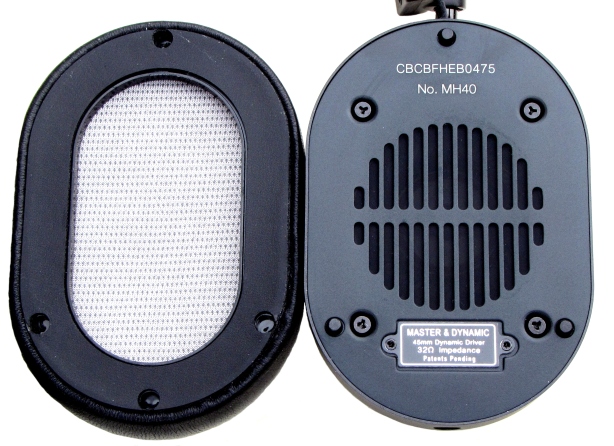
The headphone comes in a nice box which includes a cloth carrying bag and a small round leather box which contains 2 braided cables. A shorter one with a remote control (Apple only) and a longer one without the remote. Also included is a 6.3mm adapter.
The cable can be connected on the left or right side. The open connector can be used to connect a second MH40 so 2 people can enjoy music from the same source.
The cables are microphonic which means you can hear mechanical contact sounds in the headphone when the cable rubs against clothes etc. It is not annoyingly loud though but can be heard.
Below the inside of the MH40. The 45 mm driver itself is very heavily damped (membrane = 40mm diameter)
 As can be seen, the headphone is not entirely made out of metal. The protruding cupis made of ABS plastic as well as the baffle. The plastic is covered with thin metal plating.
As can be seen, the headphone is not entirely made out of metal. The protruding cupis made of ABS plastic as well as the baffle. The plastic is covered with thin metal plating.
There is a rather strange function on the headphone which I have not seen on other headphones (at least not passive ones). There is a mute button. Would rather not have had such an option as…
a: It could be pressed by accident and then there is no sound.
b: Switches are prone to go bad over time which could lead to intermittend sound.
c: As it is inside one cup only, occupying space, and is ‘leaking’ air around the switch lever, chances are the channel imbalance (seen in multiple independent measurements as well) may well be caused by the presence of this switch.
So far only nice things can be said about it. Excellent build quality and feel is important. Comfort is also important as is isolation from outside noises when used portable.
I can report that isolation is quite good so great for commuting etc. or to block out noises.
It’s not as good as some noise cancelling headphones but quite good for a closed passive headphone.
Comfort is good on my head. Clamping force is somewhat on the high side but essential for good isolation and as can be seen later to get good bass levels.
The pads are just large enough for my ears. Not recommended for people with large ears as the pads possibly won’t seal and may be partly on-ear.
The efficiency is very high. It thus plays pretty loud from a phone or small player already. The low impedance and high efficiency most likely means it can’t handle a lot of power. As Master & Dynamic aren’t very forthcoming with specifications I had to measure some myself. As distortion became high above 100mW I suspect this is its max. power rating. Not a problem when driving from portable equipment but something to whatch out for when connecting to higher power desktop amps.
When the mute button is pressed accidentally and you don’t hear anything and decide to turn up the volume and press the mute button again even momentarily high amounts of power might destroy the driver.
specifications:
Type: Over ear, closed
Usage: Home, portable
Driver type: dynamic
Pads: replaceable, memory foam with lambskin leather but alcantara is also available.
Collapsible: No, but the cups can fold flat.
Headphone connector: 3.5mm TRRS connector
Cable entry: single sided (left or right)
Cable: 1.25m terminated in 3.5mm TRRS jack with (apple) remote/mic + 2m long terminated on both sides in 3.5mm TRRS jack
Driver size: 40mm
Colour options: various
Inner Pad dimensions: depth = 21mm, Width = 35mm, height = 58mm, oval shaped
Max. power rating: unknown, assumed 100mW
Max. voltage: 1.8Vrms (5Vpp)
Max. current: 60mA
Max. S.P.L.: 124dB
Impedance: 32 Ω
Efficiency: 104dB @ 1mW
Sensitivity: 119dB @ 1V
Weight: 360 g. (without cable)
Clamping force: medium-high
Accessories: Ø3.5mm to Ø6.3mm gold-plated adapter, cloth bag, manual, warranty card, leather box that holds 2 cables and adapter.
Subjective sound description:
This is a very bassy and ‘fat’ and ‘dark’ sounding headphone. Mids have a certain ‘warmth’ to it. The high amount of bass and lower mids mask the upper mids.
Because of this the mids lack clarity and brilliance. The subdued, but pleasant and soft treble also adds to the ‘full’ and ‘dark’ sound signature.
The sound is dynamic but only in the so-called macrodynamics.
For poorly recorded pop music this tonal balance may work well but for the better quality recordings the sound is way too dark and lacking details.
For portable usage some extra bass/lows usually doesn’t hurt either so some bass lift is even desirable on the go.
Playing directly from a FiiO X3 with the bass dialed down -8dB and treble lifted +2dB the sound is pleasant and neutral. I could easily live with it with some EQ.
Measurements:
Below the frequency response of the MH40 (Left, Right)

Channel matching is poor. I have re-measured it a few times with different positions and even with L-R swapped pads but the level differences are really there.
Because the MH40 has one open headphone socket I even checked whether inserting the second cable in the empty socket could cause the difference but this made no difference.
Interestingly Tyll also measured a mismatch between L and R like did Ultrabike .
For the retail price of € 400.- I find this kind of imbalance differences not really acceptable.
Bass extension is exemplary. From 10Hz to 200Hz the response is almost ‘flat’.
From 200Hz (upper bass/lower mids) to 4kHz (upper mids) the output drops about 17dB.
This is quite a lot and shows the bassy/fat/full/overly warm character of the sound.
The 5dB drop from 500Hz to 4kHz is responsible for the ‘laid back’ mids and the missing ‘clarity’ and ‘presence’. Some people really appreciate such a tonal character but it doesn’t do it for me.
Treble goes up to 20kHz. Pretty pointless to listen to ‘hi-res’ recordings as above 20kHz there isn’t much life any more. The subdued treble means there is no ‘sparkle’ and the sound is lacking ‘air’ and finer nuances. The treble quality is not poor though. Not harsh, nor sibilant but soft and somewhat subdued. Nice for poor quality recordings.
Getting a good seal is extremely important when using this headphone. Reviews I found on the web charcterize it between bass shy and bassy. There is a good reason for the discrepancy in those reviews and it does not come down to personal preference or used equipment or product variances in this case.
The soft real leather memory foam earpads (cushions) help with getting a good seal.
However, bone/skin structural differences and wearing glasses will severly affect bass response. When your MH40 sounds light in the bass I would check how it sounds without glasses and when pressed a bit harder onto the head. When bass levels vary a lot you found the culprit.
As the baffle seems fully closed the sound quality will vary when pushing on the cups while having a good seal.
Below the Right channel is shown. Normal seal, wearing glasses with thin ‘arms’, wearing glasses with ‘thick’ arms, bottom part of the pad slightly lifted.
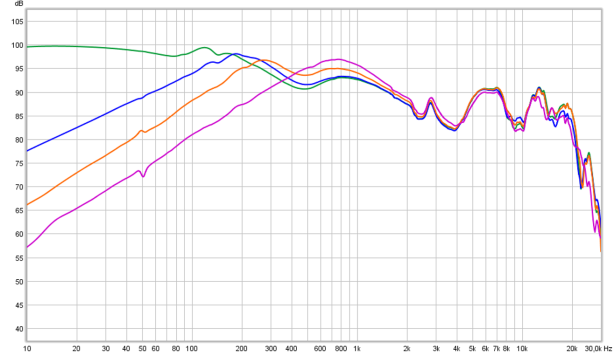 As can be seen getting a good seal is paramount for a good sound quality. This is by far the worst ‘reaction’ I have come across when looking at seal issues.
As can be seen getting a good seal is paramount for a good sound quality. This is by far the worst ‘reaction’ I have come across when looking at seal issues.
This qualifies as a design error/issue to me. A headphone does not have to be THAT seal dependent.
As mentioned the tonal balance is on the bassy/warm/thick side. The more realistic headphones have a more horizontal frequency response. Of course some people really like this type of ‘tuning’ and find it more realistic/speaker-alike than ‘flat’ headphones which are found boring and lifeless.
Below a comparison with similarly ‘tuned’ and generally well liked headphones.
To get a better ‘feel’ of tonal balance issues the plots of the headphones below are quite heavily ‘smoothed’ (1/3 octave). MH40, MDR1A and Meze 99 Classic
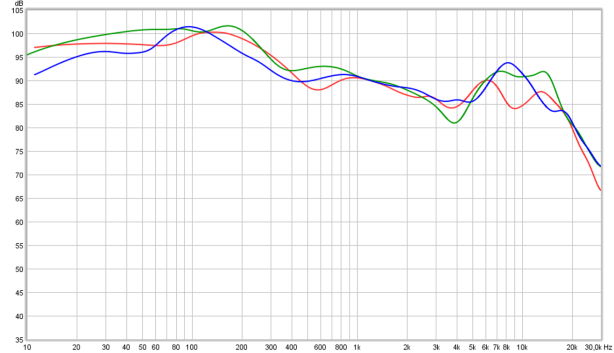
Below the comparison of the MH40 with a more polarizing headphone (Audioquest Nighthawk) and the Takstar Pro-82 on max bass level setting.

output resistance / damping-factor
As this is a dynamic headphone the frequency response can be amplifier output resistance dependent when certain higher output resistance amplifiers are used.
Instead of showing impedance plots, which are hard to interpret properly when it comes to assessing the effect in the real world, the MH40 is measured via a low resistance output (0.2Ω) and a high resistance output (120Ω).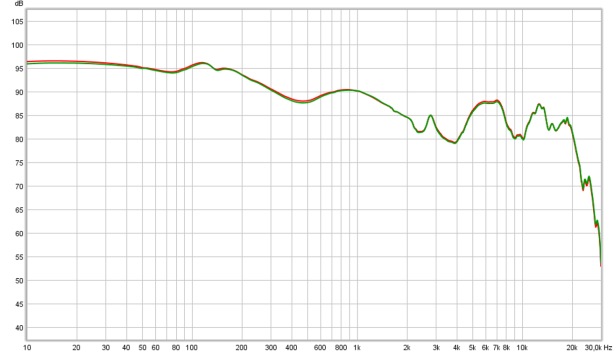
On a high output resistance amplifier the output level will be 12dB lower. To compensate for this the amplifier is cranked up to the same level (at 1kHz). This way the plots are overlaid and it is easier to see how the tonal balance changes.
As can be seen the tonal balance does not change when connected to a higher output resistance amplifier. So no need to worry about output resistances of sources.
Below the distortion measurements of the MH40 (Left channel).

The plot above shows the level differences (in dB) between the signal and the harmonics. Most people prefer to see percentages instead of level differences so below the exact same plot except ‘normalised’ to the actual signal and level differences given in percentages.
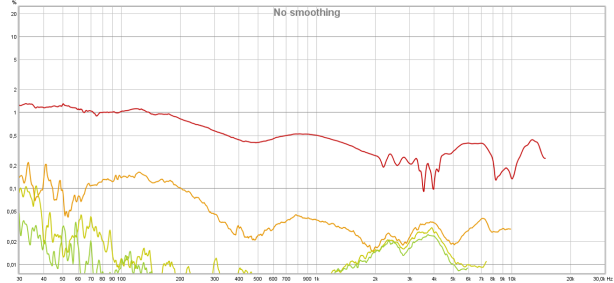
Distortion levels are quite decent. Around 1% 2nd harmonic distortion in the bass is good. The 3rd harmonic (which sounds like clipping) is impressively low.
The actual 2nd harmonic distortion above 200Hz may well be lower than 0.5%. A shortcoming of my measurement rig.
Time domain
Below the CSD (waterfall) plot of the MH40. Left and Right are overlaid.

There is a considerable ringing at 3kHz and mids are lingering longer than they should.
Below the CSD plot of the left channel only. The interesting part here is that the 3kHz ringing is shorter lived as well as the lingering in the mids.

There seem to be more differences between the left and right driver than just frequency response.
Below the spectrum plot of the MH40 (Left channel). This basically is a CSD (Waterfall) plot but viewed from above where the level differences are colour coded instead of being in the vertical axis. Also the frequency range of the spectrum plot is wider (from 100Hz instead of 500Hz). The time span is also bigger in the spectrum plots and expired time is shown from below to top where in the CSD the time is shown from rear to front.
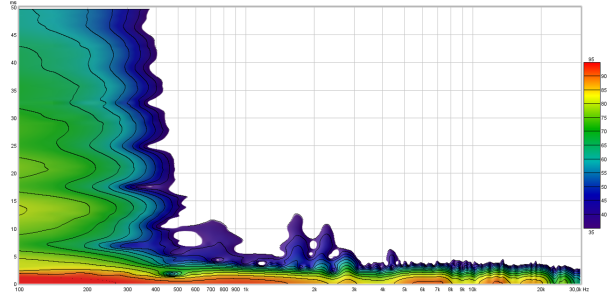
The lingering till 400Hz is quite obvious and have not seen lingering in this severity.
This results in bass being not very well defined and lacking ‘tightness’.
There are resonances visible at around 1.7kHz, 2.3kHz and 2.9kHz.
Below the step response of the MH40. Only the left channel is shown which performs fairly similar to the right channel.
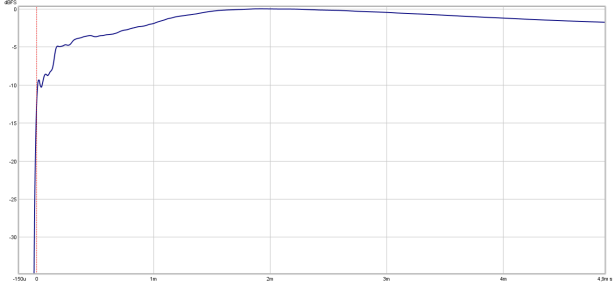
The horizontal line shows the phenomenal subbass extension. The initial rising edge is not reaching the same levels as the lows which again is evidence of the ‘bassy’ and overly warm sound which is lacking in clarity and ‘attack’
The driver itself seems very well damped. Maybe even somewhat overdamped as there is almost no overshoot/ringing visible.
Below the square-wave response at 40Hz, 440Hz and a 100μs pulse response.
The measured signal should match the applied signal as close as possible.
The slight time delay is actually caused by the speed of sound. It takes approx. 100μs for the sound to reach the microphone.
In the 40Hz plot the bass boost is clearly seen as the measured amplitude is considerably higher than the applied signal . Bass extension is excellent as the measured signal actually looks a lot like a squarewave.
The 440Hz signal looks less like a squarewave and shows the lack of ‘clarity’ as the rising and falling edges are smaller than the stimulus. The signal going above the stimulus is evidence of the bass boost affecting the mids as well.
The 100μs pulse shows a decent rising edge. Just like in the 40Hz and 440Hz square-wave signals there is no overshoot and ringing visible. The measured signal does not reach the target level but comes close. The membrane has trouble going back to the neutral line. The pulse is widened by about 50μs. This may well be some evidence of the lack of ‘resolution’ as the higher frequencies are ‘smeared’ a bit in time.
Conclusion
This headphone is an engineering marvel and seems really well constructed and has a nice industrial look. Comfort is quite good. For € 400.- one should at least expect a decent to good quality headphone.
Those looking for a highly detailed headphone with a neutral tonal balance can skip this headphone. It has a bassy and overly dark/fat/warm character.
Not suited for classical, Jazz or other well recorded material. Better suited for Pop music and rock music for instance.
A good seal is essential. No seal is no bass and honky mids. In my opinion a design error or oversight. Also the channel imbalance is something I would not expect in such a finely machined headphone. Microphony of the cable also is something that is somewhat disappointing despite the looks and feel of the supplied cable.
One can easily say that the sound quality is not on par with the mechanical quality.
A slightly cheaper and also well made alternative would be the Meze 99 classic or Sony MDR1A. I prefer this headphone over the AQ Nighthawk.
With EQ this headphone sounds better but not quite the same level as a lot of other headphones in this price class. It won’t have the build quality of the MH40 though.
passive filter
This headphone is way too bassy/fat to me so I use it with EQ. For those who find it too bassy/dark as well but like the quality the filter may be a viable option.
Fortunately, because of it’s fairly flat impedance it is easy to make a passive filter for it that corrects the tonal balance to ‘neutral’. Stock and with filter
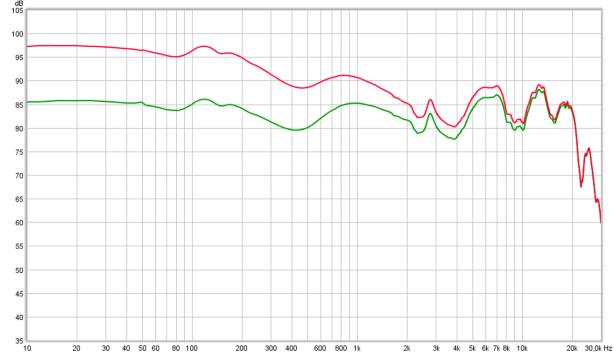
As can be seen this goes at the expense of some of the efficiency. This isn’t really a problem as the efficiency is very high (104dB/mW). The headphone becomes about 7dB less efficient so is still a very respectable 97dB/mW.
Below the diffence in perceived tonal balance (1/3 octave smoothed and level matched)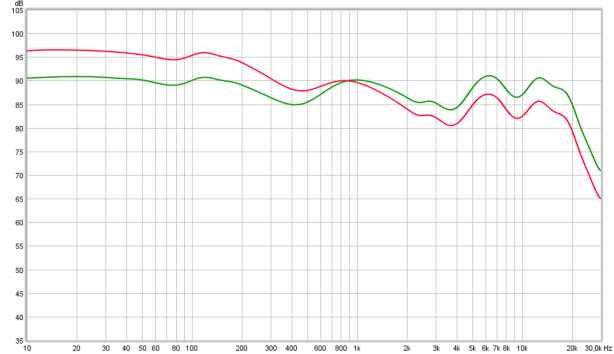
Those who are wondering how much further down this headphone extends below 10Hz below a plot (left channel only) of the MH40 (with filter) with the frequency scale from 2Hz to 20kHz. That is TWO Hertz…. not a typo.

The result is a far more natural sounding headphone with more clarity and present treble.
The channel imbalance is still there of course so below the frequency response Left and Right.
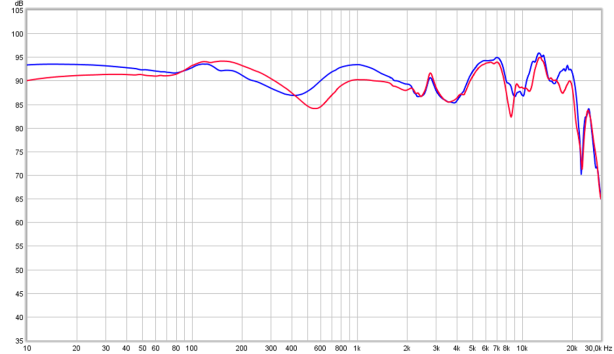
Below the differences between stock MH40 (left side) and via the filter (right side)

The 40Hz measured signal is much closer to the applied signal. Note the vertical scales differ. The 440Hz looks more like a square-wave. The 100μs pulse is now reaching the correct level . The double pulse of course did not change but now crosses the 0V line.
The filter consists of 4 components per channel and can be made into a short extension cord for instance.
The amount of bass/warmth can be ‘tuned’ by lowering the value of R1 and R3.
The lower the value the less bass levels will be reduced.
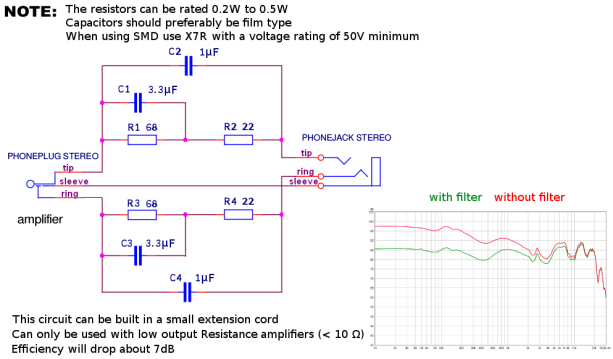
The MH40 is now tonally correct but still lacks in finer nuances. Also the seal issue is still there and so is the microphony of the cable.

